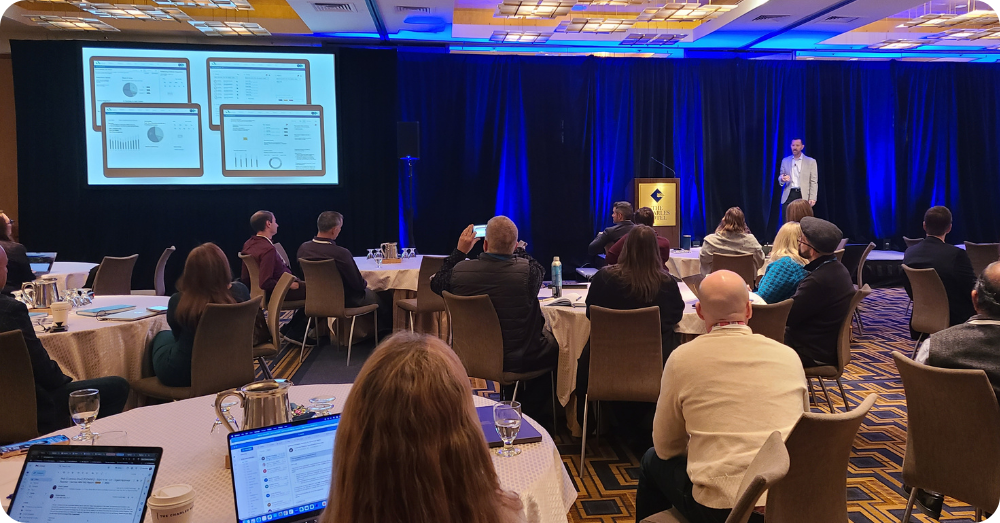At our first open session of 2025, one word stole the show — and yes, it starts with “A” and ends with “I.”
It’s no surprise that artificial intelligence is a hot topic among analyst relations (AR) professionals. Who isn’t talking about AI these days? What was surprising, though, was how thoughtfully and creatively AR teams are already putting it to work — and seeing real results.
Participants came together to candidly share their experiences with AI (the wins, the workarounds, the wish lists). They also explored how these tools are influencing bigger-picture dynamics — like the evolving relationship between AR and sales.
Here’s a closer look at the biggest takeaways and what they could mean for your AR strategy in 2025.
AI + RFI = ROI
For AR teams, RFIs are a never-ending parade. They’re necessary, repetitive and time-consuming — especially when you need to gather and validate details from multiple teams. But with generative AI (GenAI), AR pros are getting faster and smarter about how they tackle them. Tools like ChatGPT and Claude are helping draft and update responses, slashing busywork and freeing up time for higher-impact work.

One standout use case? Comparing this year’s RFI to last year’s. Like finding that elusive missing sock in the Mount Everest of laundry, it’s a surprisingly effective way to catch subtle shifts in phrasing — the kind of detail that’s easy to miss in a manual review but could signal meaningful changes in analyst focus or shifting priorities.
And here’s a game-changing hack that came up in discussion: Say goodbye to manually typing every question. Just screenshot the RFI and paste it into your AI tool to get started.
Turning AI into your own subject matter expert
One of the most valuable ways AR teams are using GenAI? Training it like a team member. By fueling your tool with internal resources — think messaging decks, release notes, product details and platform-specific terminology — you can essentially teach it how your company communicates. The more context you provide, the quicker they’ll speak your language and represent your brand accurately.
The payoff? Fewer time-consuming back-and-forths with product, engineering and product marketing teams — and more accurate, on-brand answers that that highlight your unique differentiators.

When AR and sales share AI, everyone wins
As sales teams increasingly bring AI into their workflows — especially for crafting prospect RFIs — AR pros are finding fresh ways to collaborate and raise the bar. AR responses tend to be more polished and insight-rich (thanks to that analyst-facing lens), and they’re quickly becoming a blueprint for sales to follow. When both teams use the same tools and align on messaging, everyone benefits.
AR and sales teaming up on AI? That’s where things get really interesting. Shared tools make it easier for AR to jump in with targeted support, whether that’s refining messaging, helping with deal reviews or offering insight into what different buyers care about. The result is seamless collaboration, better alignment and a clearer link between AR efforts and revenue. It also makes a strong case for expanding your AR team, especially in smaller orgs where formal analyst engagement is still gaining traction.
AI still needs a human touch
AI can bring tremendous benefits to AR teams: speeding up research, drafting RFI responses and surfacing insights faster. But it’s an assistant, not a replacement. Responses still require an accuracy check, and AI can often default to generic language. That human review is still key to making sure your differentiators shine through.
There are a few practical watchouts, too. Free tools often collect the data you input, so be cautious with proprietary or sensitive information. Paid versions typically offer stronger privacy controls — just be sure your settings are up to date, and you stay on top of changes to Terms of Service agreements.
Bottom line: The AI learning curve is worth climbing
AI tools are evolving fast. What felt clunky — or wildly inaccurate — just a few weeks ago might already be producing much more reliable results. The more you experiment, refine your prompts and integrate GenAI into your workflow, the more value you’ll unlock.
As one attendee put it: “Just stick with it. Keep practicing, keep using it, and then all of a sudden, you’ll find out, ‘Oh, wow — something that used to take hours now takes minutes.’”




